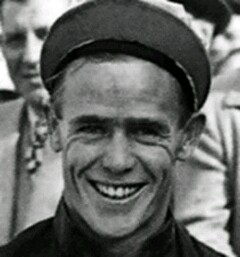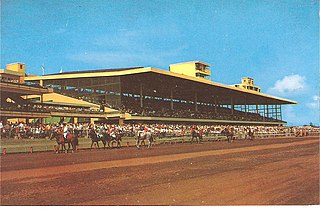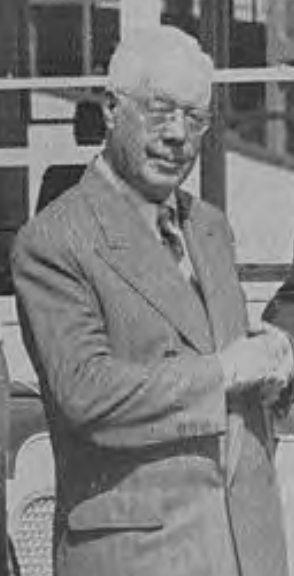Related Research Articles

Whirlaway was a champion American Thoroughbred racehorse who is the fifth winner of the American Triple Crown. He also won the Travers Stakes after his Triple Crown sweep to become the first and only horse to win all four races.

Albert Snider was a jockey in Thoroughbred racing who had success in his native Canada as well as the United States.

Alsab (1939–1963) was an American Hall of Fame Thoroughbred racehorse.

Narragansett Park was an American race track for Thoroughbred horse racing in Pawtucket, Rhode Island.

Robert Emmet Quinn was an American attorney and politician from Rhode Island. He served as the 58th Governor of Rhode Island and Judge for the Rhode Island Superior Court.
The Havre de Grace Handicap was an American Thoroughbred horse race first run on the August 26, 1912 opening day of the new Havre de Grace Racetrack in Havre de Grace, Maryland. Although most of its runnings would take place in early fall, its final edition was run there on April 30, 1949. Due to Federal government wartime regulations, the 1943 edition was held at Laurel Park and in 1945 at Pimlico Race Course. A race for horses age three old or older, it was run on dirt over a distance of 1 1/8 miles with the exception of 1918 when it was set at 1 mile and 70 yards. From inception through 1939, the race was known as the Havre de Grace Cup Handicap.
The Narragansett Special was an American Thoroughbred horse race run annually at Narragansett Park in Pawtucket, Rhode Island. At the time of its inaugural running in 1934, the Narragansett Special offered a purse of $32,500 added money making it the biggest race run at the track. Only Suffolk Downs' Massachusetts Handicap, which ran the next summer, had a bigger purse in New England. Both rich contests drew the best talent that the nation had to offer.

James E. Dooley (1886–1960) was a leading sports figure in Rhode Island. He became part owner of the Providence Steam Roller of the National Football League from 1916 until 1933 when the team folded. The 1928 team won the NFL Championship with an 8-1-2 record. He has a decades-long association with the Narragansett Park race track in Pawtucket. Dooley was also a founder of the Providence Reds of the Canadian-American Hockey League (CAHL) and was also the one-time President of the CAHL.
Jamestown (1928–1953) was an American champion Thoroughbred racehorse. He was bred and raced by George D. Widener Jr., an Exemplar of Racing described by the Sarasota Herald-Tribune newspaper as "one of thoroughbred racing's most respected horsemen."

Pompey (1923–1944) was an American Champion Thoroughbred racehorse.
Walter Edmund O'Hara was an American horse racing executive who was the first President and Managing Director of the Narragansett Racing Association, which owned and operated Narragansett Park, a Thoroughbred horse track in Pawtucket, Rhode Island.
The Rhode Island Handicap was an American Thoroughbred horse race run annually at Narragansett Park in Pawtucket, Rhode Island from 1934 to 1948. The race was designed to be the closing day feature of the tracks very first meet. The handicap event was given a $10,000 purse, the largest of the meet. Older handicap horses were the racing stars of the day and the Rhode Island Handicap was to be the track's signature race.
The 1928 Preakness Stakes was the 53rd running of the Preakness. The race took place on Friday, May 11, 1928, eight days before the Kentucky Derby making it the first leg of the U.S. Triple Crown series. A horse race for three-year-old thoroughbreds, it carried a total purse of $71,370. It was run on a track rated fast in a final time of 2:00 1/5. Ridden by future U.S. Racing Hall of Fame inductee Raymond Workman, Victorian won the race by a nose over runner-up Toro. Nassak, the betting favorite from the powerful Rancocas Stable finished a distant 11th. The fifth-place finisher, Sun Beau, went on to a brilliant racing career and was voted U.S. Champion Older Horse in three straight years culminating with his 1996 induction into the U.S. National Museum of Racing and Hall of Fame.
Lester Anthony Balaski was an American Thoroughbred horse racing jockey, a soldier who served his country during World War II, and a founding director and a First Vice-President of the Jockeys' Guild who died as a result of injuries suffered in an August 22, 1964, racing accident at Agua Caliente Racetrack in Mexico. A resident of Chula Vista, California, he had been transported from the racetrack to Mercy Hospital in San Diego, California where he died ten days later.
Whichone (1927–1944) was an American Thoroughbred racehorse who was named the American Champion Two-Year-Old Colt of 1929. Although Whichone earned important race wins as a three-year-old, injuries hampered his racing career including a bowed tendon sustained in the running of the 1930 Travers Stakes that ended his career.

The 1938 Rhode Island gubernatorial election was held on November 8, 1938. Republican nominee William Henry Vanderbilt III defeated Democratic incumbent Robert E. Quinn with 54.17% of the vote.
The Chesapeake Stakes was an important American Thoroughbred horse race for three-year-old horses of either sex contested on dirt over a distance of a mile and one-sixteenth at Havre de Grace Racetrack in Havre de Grace, Maryland. Run from 1920 until the track closed after the 1950 edition, the race usually run in late April race was a last major prep before the Kentucky Derby. For owners who had not nominated their horse for the Derby it was a chance to test their horse's ability against some of the best three-year-olds in the country, a number of which they would undoubtedly encounter in the ensuing Preakness Stakes.
The New England Oaks was an American Thoroughbred horse race held annually from 1936 thru 1944 at Narragansett Park in Pawtucket, Rhode Island. Run on dirt over a distance of a mile and one-sixteenth, like all "Oaks" races for Thoroughbreds, it was open to three-year-old fillies only.

Martimas (1896-1916) was a Canadian Horse Racing Hall of Fame Thoroughbred racehorse who competed in Canada as well as the United States where he won the Futurity Stakes, the richest and most prestigious race in the country.

Narragansett Park was an American horse and motor racing venue in Cranston, Rhode Island.
References
- ↑ Daily Racing Form October 8, 1926 article titled "Pompoon to be Pointed for Rich New England Futurity on Oct. 28" Retrieved August 8, 2018
- ↑ Daily Racing Form October 29, 1936 article titled "Chicago's Reaping Reward Defeats Pompoon" Retrieved August 8, 2018
- ↑ Somerset (Pennsylvania) Daily American Newspaper Archives October 20, 1937 - Page 2 article titled "Governor’s Martial Law Stops Running Of Annual Futurity Stake" Retrieved August 8, 2018
- ↑ Challedon at the National Museum of Racing and Hall of Fame Retrieved August 8, 2018
- ↑ Daily Racing Form October 27, 1938 article subtitled "Some of the Best Youngsters in the Country to Face the Barrier for Race" Retrieved August 7, 2018
- ↑ Courier-Journal (Louisville, Kentucky) October 29, 1939 page 56 article titled "Straight Lead Takes $52,310 Futurity" Retrieved August 7, 2018
- ↑ Courier-Journal (Louisville, Kentucky) October 5, 1940 page 17 Retrieved August 7, 2018